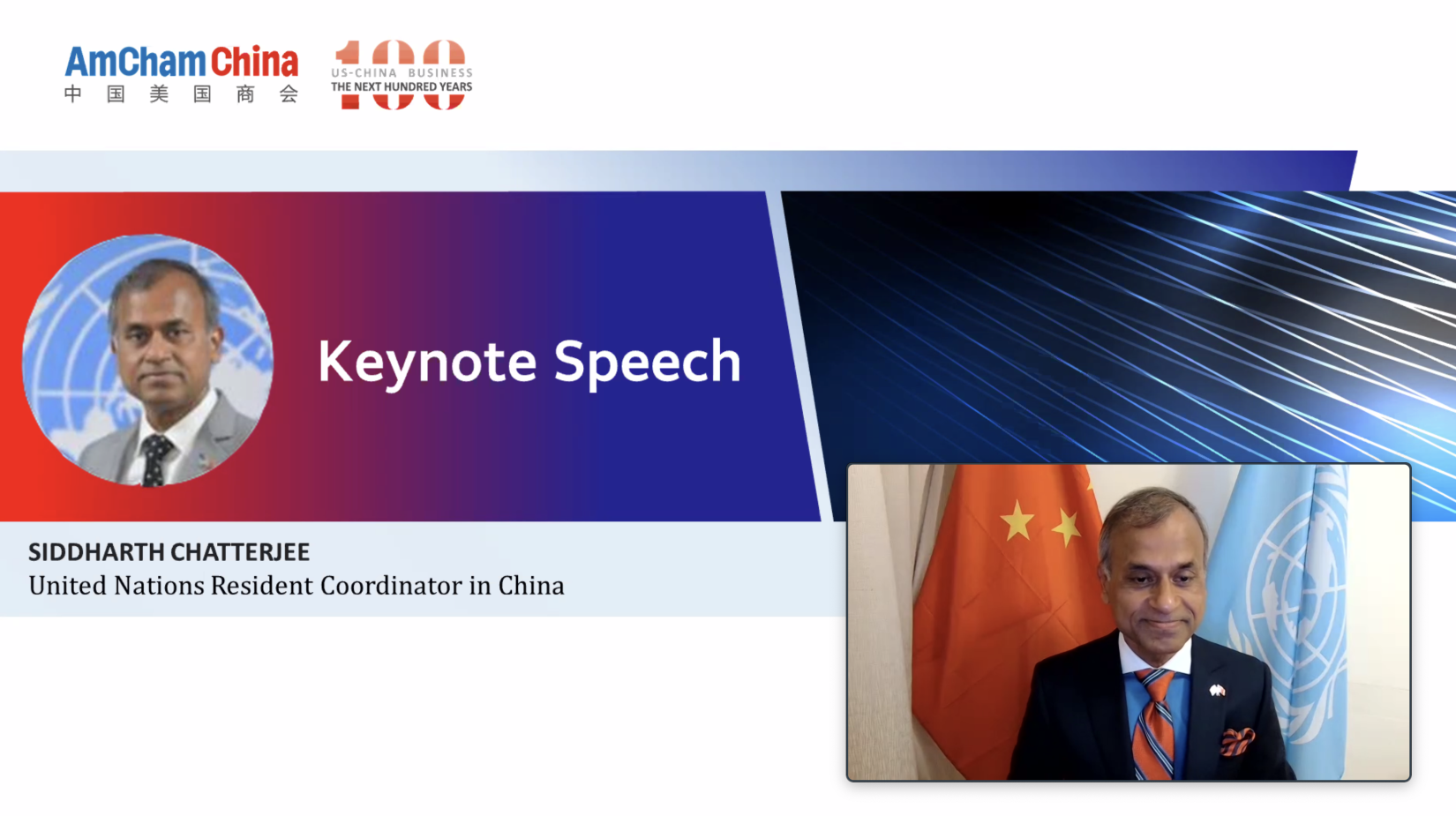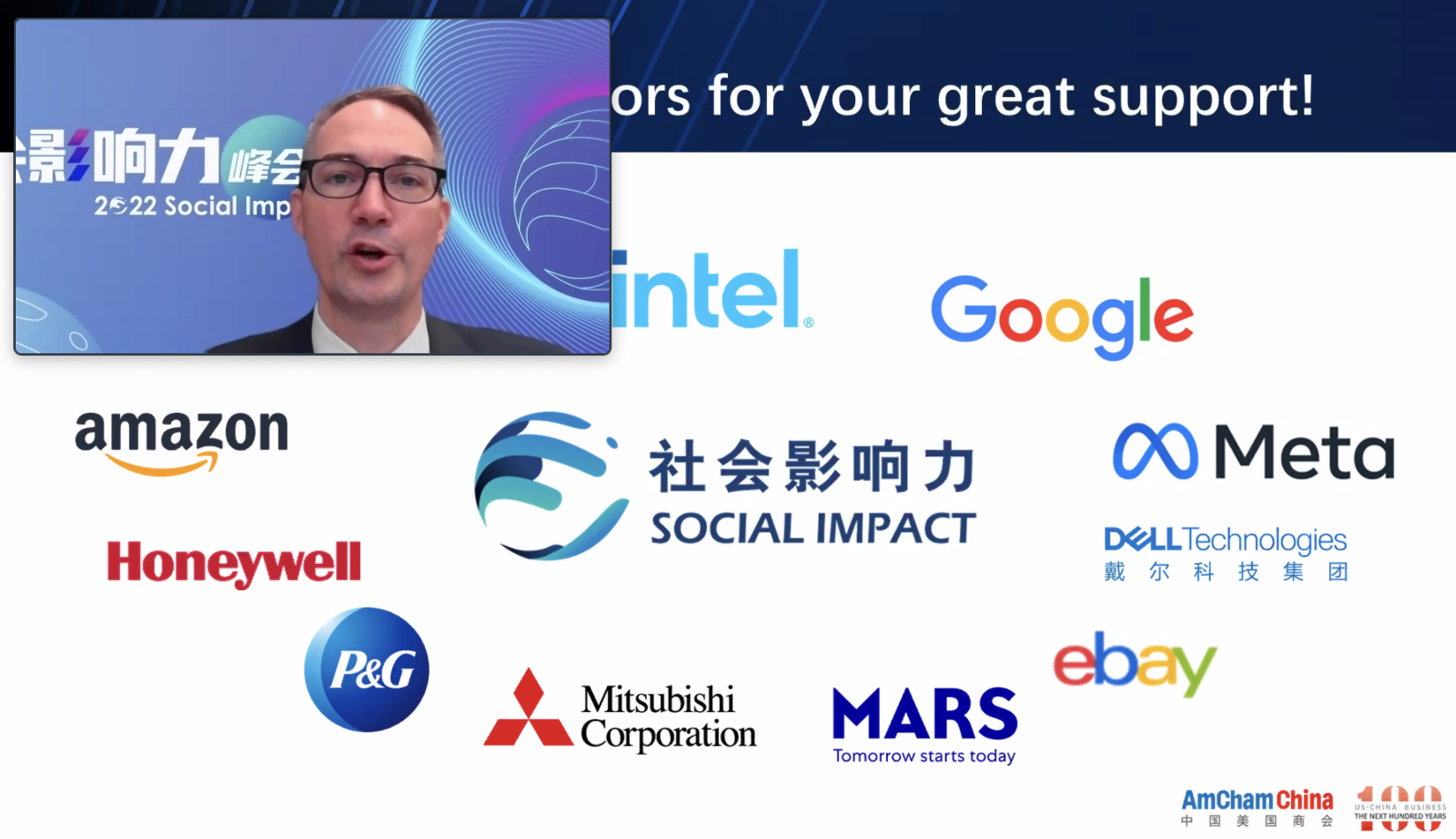2022 Social Impact Summit
Remarks by Siddharth Chatterjee, UN Resident Coordinator in China, for AmCham China

(Check against delivery)
Mr. Michael Hart, President, AmCham China,
Distinguished moderators and panellists,
I want to thank the American Chamber of Commerce in China for the invitation to speak at the 2022 Social Impact Summit.
The world today is at a crucial point of no return as we face a series of global tests. Over two years into the COVID-19 pandemic, we have seen unprecedented socio-economic impacts. In addition, climate change, conflicts, growing inflation, digital divides, rising poverty and hunger, and structural inequalities between and within countries exacerbate the situation while threatening decades of development gains.
In his address at the High-Level Political Forum yesterday in New York, UN Secretary-General António Guterres stressed for Member States to come together to rescue the Global Goals before it is too late. He said, “We know what we need to do: End the senseless, disastrous wars – now. Unleash a renewable energy revolution – now. Invest in people and build a new social contract – now.”
Addressing these global crises requires international cooperation and solidarity, and it is abundantly clear that multilateralism remains our best hope of tackling shared challenges. We are glad to see that despite differences in the bilateral relationship, China and the United States have agreed to collaborate more closely on climate action through the China-U.S. Joint Glasgow Declaration on Enhancing Climate Action in the 2020s, at the 26th Session of the Conference of the Parties to the UN Framework Convention on Climate Change held in Glasgow last year.
As the world's two largest sources of carbon emissions, this agreement between China and the US to work together and with all parties to strengthen the implementation of the Paris Agreement is, as the UN Secretary-General said, “an important step in the right direction”. The UN welcomes more bilateral or multilateral consensus and cooperation as needed to accelerate the 2030 Agenda for Sustainable Development, and will always welcome initiatives by any Member State that marshal ideas, capacities, and resources in support of the SDGs. The UN is the place to create a coalition of political will to tackle carbon emissions and other global challenges.
On 25 April this year, I was honoured to meet China’s Foreign Minister H.E. Wang Yi, at a bilateral meeting. We discussed the UN-China partnership and its importance in accelerating global progress on the SDGs. We also discussed the Global Development Initiative (GDI) and its potential in realizing the promise of the 2030 Agenda for Sustainable Development. During our bilateral meeting, I expressed how it is useful to share China’s relevant lessons and experiences with the rest of the developing world, with the UN as a potential bridge for further and more effective South-South Cooperation and South-South learning. I also stressed the need for the GDI to embrace all equally important dimensions of sustainable development, including human rights, and peace and security fully aligned to the spirit of the Global Goals. The UN stands ready to provide full technical support to ensure the GDI matches international norms and standards.
The UN acts as a bridge not only for cooperation among Member States, but also for partnerships between public and private sectors. To deliver on this promise, the UN is finding new ways of working together to build a more networked and ‘fit for purpose’ form of multilateralism, bringing in all sectors of society from all Member States. Leveraging Public-Private Partnerships to make the most of relevant expertise, technology and resources will play an important role. This work is made possible by our colleagues at UN Global Compact.
Last month, I was invited to speak at the 2022 UN Global Compact Leaders Summit. I was encouraged to see that the panellists agreed that multilateralism, especially through Public-Private Partnerships, is essential for global recovery, and that business can play an important role in achieving the SDGs. The Summit attracted nearly 13,000 attendees from over 160 countries – almost 20% of which were from the U.S. and China – the highest two countries in terms of attendees. It is clear that the importance of Public-Private Partnerships is increasingly acknowledged by stakeholders across the world.
I am happy to report that nearly 1,500 business and non-business organizations from China and the U.S. have made a commitment to the Ten Principles of the UN Global Compact. But we need more companies and organizations to join, commit, act, influence and change course. Given our world of more socially conscious consumers, we would encourage you to take the initiative to meaningfully embed the SDGs into your business strategy and operations to ensure the longevity and success of your organization.

In Kenya, and under the leadership of the government, the UN has built a model to catalyse public-private action: the SDG Partnership Platform. It is a tested instrument for engagement that has brought together a variety of private players in previous initiatives to co-create and rapidly deploy, with government, large-scale shared-value solutions to address the challenges our societies and the planet are facing. It is through such a mechanism, for example, that the UN mobilized the private sector to carry out a maternal mortality reduction campaign in Kenya’s north-eastern counties, one that was recognized as a global best practice.
Kenya, where I served as head of the UN Population Fund and later as Resident Coordinator, faces one of the highest maternal death rates in the world. Tacking this challenge with support from the Government of Kenya, the UN family sought to break the orthodoxy by bringing in five companies: Huawei from China, Merck from the USA, GSK from the UK, Phillips from the Netherlands, and Safaricom from Kenya to partner with the UN and the Government of Kenya to address maternal mortality in six high-burden counties. In less than three years, this partnership led to a one-third reduction in maternal mortality in those counties, progress which in many countries would likely take anywhere from 10 to 15 years. We invested USD 15 million from a UN trust fund and that, in turn, had a multiplier effect creating a USD 150 million telemedicine programme. These achievements were later highlighted through an invitation to the World Economic Forum in January 2017.
The Kenyan model of cooperation could take shape all over the world. Such models allow governments to foster an ecosystem of purposeful partnerships; to amplify private-sector philanthropy, corporate social responsibility and policy advocacy for national mitigation; and to accelerate shared-value partnerships. It also allows the UN to play its role as a neutral broker, and steer a much-needed balance between lethargic action on one hand and misdirected reactions on the other.
The potential for Public-Private Partnerships is unlimited. Currently, the UN in China is proposing a new SDG Partnership Platform that hopes to leverage the experiences and resources of China to promote rural revitalization, agribusiness development and other priority areas for the SDGs, especially in Africa.
I am delighted to see that my colleagues across different UN agencies in China have already been working on pilot projects in Public-Private Partnerships, focusing on innovation. By investing in digital transformation, we can reshape our way of working, helping us to reach more people in need and better serve them. Responding to this opportunity, the UN Global Compact in China, through the theme of ‘Digital for Climate’ is advancing an important pilot project as part of the “Action Platform on Sustainable Infrastructure for the Belt and Road Initiative to Accelerate the SDGs”. In leveraging corporate whole-value-chain digital approaches and innovative solutions, the project seeks to address maritime litter and climate change issues along Belt and Road Initiative countries.
These are just some of the many examples of Public-Private Partnerships in action, and I hope to soon hear about how your collaborations between the public and private sectors are creating a positive impact.
Ladies and gentlemen,
There is the global challenge of climate change. Without the free movement of technologies and financing, the world will have no chance of limiting global warming to 1.5 degrees Celsius above pre-industrial levels. Here, too, success will depend on whether the U.S. and China can work together.
With so many common challenges, there can be a reasonable balance between strategic competition and strategic cooperation. After all, both China and the U.S. would benefit from acknowledging that they have compelling common interests, not just unavoidable disagreements. Together they can help accelerate the SDGs and bring the world back to peace, stability, and prosperity.
Indeed, the U.S. Special Presidential Envoy for Climate, John Kerry, has said the transition to a global economic model which will slow down climate change and create jobs will be the “biggest economic transformation since the industrial revolution”.
We stand ready to support and provide a platform to convene, connect and catalyse partnerships for sustainable development. That is the UN Secretary-General’s vision of a United Nations that is fit for purpose.
I wish you successful deliberations.
Speech by


